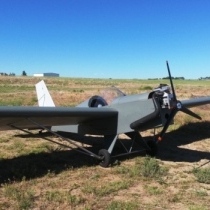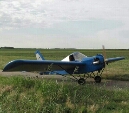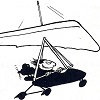|
|
 Keith103 Keith103 |
|
 Ace Ace Posts: 632
Time Online: 13 days 6 hours 31 minutes
|
This is about the yawing tendencies on take-off roll. We know about the gyroscopic effect on the prop while moving the stick forward to lift the tail. But I was a bit surprised at the amount of right rudder I needed to apply. ( My prop turns clockwise viewed from the pit. ) Before I lift the tail, the P factor makes the bird yaw left, while lifting the tail the gyro effect makes it yaw left, and after tail is up, both tendencies disappear. Is that how it is supposed to work ? I think the prop wash also makes it yaw to the left. I have the steering rod, and I wonder if that also adds to the fun. https://www.boldmethod.com/lea.....on%20to%20the%20left. === |
|
 Logged Logged |
|
|
|
|
 BlueMax BlueMax |
|
 1550 Vmax w/ Eros canopy mod Ace Posts: 1,244
Time Online: 35 days 15 hours 47 minutes
|
When you give the engine a fist full of throttle you are feeling torque more than anything else, the faster you add power the more rudder you need to hold against it. As the airplane accelerates and the tail lifts the vertical stabilizer starts to become effective at dampening the yaw moment and the torque effect begins to decrease as the speed increases. At near flying speed the airplane should track fairly straight of its own accord. in the climb after takeoff you are really only dealing with a little bit of torque effect but a lot of p factor depending on airspeed and angle of climb, the steeper the climb the stronger the P factor and the more rudder required to keep it straight.
the steering rod really only comes into play after landing when rolling out at a dead idle, particularly on pavement. on a conventional chain and spring setup, the faster you go the more the springs stretch and the less the tailwheel can be influenced by ridder inputs. with the direct steering rod, the tailwheel steering ratio remains constant regardless of speed.
Chris |
| Remember, in aviation death sentences are administered by the laws of physics, not the FAA. |
|
|
|
|
|
 LSaupe LSaupe |
|
Flight Leader  Posts: 161
Time Online: 1 days 10 hours 40 minutes
|
Yes, that is how it is supposed to work. Those two factors disappear. Torque will remain however. When you pitch the aircraft (nose up) again, then the right descending blade will have higher AOA then the left ascending blade and the P factor returns. |
|
|
|
|
|
 Keith103 Keith103 |
|
 Ace Ace Posts: 632
Time Online: 13 days 6 hours 31 minutes
|
Thank you for your thoughts on the subject. A MiniMax takeoff happens so quickly ( about 8 or 9 seconds till you lift off ), that all these happen in a blur. Mostly you are just trying to counteract any yaw with rudder, as required. The gyroscopic effect is more discernible while lifting/lowering the tail during fast taxiing. This guy in this video does not even lift the tail on takeoff : https://www.youtube.com/watch?v=NtBAdGdtUIU&t=45s=== |
|
 Logged Logged |
|
|
|
|
 cdlwingnut cdlwingnut |
| September 12, 2020, 12:47pm |
|
Ace
Posts: 416
Time Online: 3 days 22 hours 22 minutes
|
the prop has 4 turning tendencies
1. Torque: the prop spins one way the opposite and equal reaction is for the plane to want to go the other. The more power the more torque. In your airplane with the prop spinning clockwise as seen from the cockpit it is a left turning tendency.
2. Spiraling Slipstream: the air pushed by your prop spins around your fuselage hitting the rudder. in your airplane it hits the left side of the rudder pushing the tail right and the nose left. again more power more left turning tendency.
the next two are a little more confusing
4. P-factor: when there is a positive angle of attack on the airplane the down blade of the prop takes a bigger bite of the air thus giving more thrust. In your airplane the down blade is the right one so the right side has more thrust than the left so it pulls the plane to the left.
5. Gyroscopic precession: a force applied to a spinning gyro the resultant force will be 90 deg in the direction of rotation. think spinning a hula hoop so when you throw it it bounces back to you. in your airplane when you pitch up it goes right, down-left, hit right rudder- down, left rudder-up
ok now lets look at a normal take off in your plane. at the start it is sitting at a positive angle of attack so P-factor is working, high power so high torque and spiraling slip stream. then you lift the tail, as the tail goes up gyro precession wants to move the nose to the left, but goes away once the tail stops moving.P factor is dimminished though. still high torque and slipstream. now rotate. gyro is applied again but to the right and you add in p-factor again. hence the rudder dance with a tail dragger. |
|
|
|
|
|
 Keith103 Keith103 |
| September 25, 2023, 6:05pm |
|
 Ace Ace Posts: 632
Time Online: 13 days 6 hours 31 minutes
|
Thanks cdlwingnut.
I hadn’t read this reply earlier.
Saw it only today during a search for something else.
Well explained.
|
|
 Logged Logged |
|
|
|
|
 Antoni Antoni |
| September 26, 2023, 7:35pm |
|
 'Max, Chaser and Quik fan Ace Posts: 228
Time Online: 2 days 2 hours 53 minutes
|
the prop has 4 turning tendencies
1. Torque: the prop spins one way the opposite and equal reaction is for the plane to want to go the other. The more power the more torque. In your airplane with the prop spinning clockwise as seen from the cockpit it is a left turning tendency.
2. Spiraling Slipstream: the air pushed by your prop spins around your fuselage hitting the rudder. in your airplane it hits the left side of the rudder pushing the tail right and the nose left. again more power more left turning tendency.
the next two are a little more confusing
4. P-factor: when there is a positive angle of attack on the airplane the down blade of the prop takes a bigger bite of the air thus giving more thrust. In your airplane the down blade is the right one so the right side has more thrust than the left so it pulls the plane to the left.
5. Gyroscopic precession: a force applied to a spinning gyro the resultant force will be 90 deg in the direction of rotation. think spinning a hula hoop so when you throw it it bounces back to you. in your airplane when you pitch up it goes right, down-left, hit right rudder- down, left rudder-up
ok now lets look at a normal take off in your plane. at the start it is sitting at a positive angle of attack so P-factor is working, high power so high torque and spiraling slip stream. then you lift the tail, as the tail goes up gyro precession wants to move the nose to the left, but goes away once the tail stops moving.P factor is dimminished though. still high torque and slipstream. now rotate. gyro is applied again but to the right and you add in p-factor again. hence the rudder dance with a tail dragger.
Very clear explanation. When learning to ride a unicycle in my mid fifties I understood the theory of how it could be instructed to proceed in the desesired direction but there was absolutely no chance my brain could command my body's muscles to achieve same in the required time span. You just try to do it until you can do it. Minimaxes are VERY much easier to operate and understand than my unicycle. The unicycle did not care at all if we parted company. There's the difference, but the principle is the same. |
|
|
|
|
|
 beragoobruce beragoobruce |
| September 27, 2023, 12:40am |
|
Built an Eros - now I'm flying it! Ace Posts: 1,067
Time Online: 19 days 10 hours 59 minutes
|
My Eros is fitted with a 60hp MZ202 engine. My take-off technique was to hold the stick steady & apply full power. The plane just flew off the ground in seconds. Still needed a bootful of right rudder though. |
|
|
|
|
|
 Keith103 Keith103 |
| September 27, 2023, 4:38pm |
|
 Ace Ace Posts: 632
Time Online: 13 days 6 hours 31 minutes
|
Very clear explanation.
When learning to ride a unicycle in my mid fifties I understood the theory of how it could be instructed to proceed in the desesired direction but there was absolutely no chance my brain could command my body's muscles to achieve same in the required time span.
You just try to do it until you can do it.
Minimaxes are VERY much easier to operate and understand than my unicycle. The unicycle did not care at all if we parted company. There's the difference, but the principle is the same.
Home builders may already know what I am about to say. To feel gyroscopic effect in everyday life, turn on your electric rotary grinder, and try to spin it along its axis , and feel the resistance / forces acting in a different direction than the twisting force you applied. |
|
 Logged Logged |
|
|
|
|
 Antoni Antoni |
| September 30, 2023, 7:36pm |
|
 'Max, Chaser and Quik fan Ace Posts: 228
Time Online: 2 days 2 hours 53 minutes
|
Slightly off topic but
I liked the idea of fitting a gyro turn and slip in the Minimax. It needed a 400Hz high voltage supply. Got it working with the help of a PIC and the correct transformer.
Holy shit it was weird.
During the power supply designing and testing, after it spun up in my hand it would resist being 'moved'.
But...
after the turn needle reached its end stop because of turning it in my hand, the instrument would move freely until the needle came off an end stop, then it would resist moving it again.
The above might not make much sense. I can't explain why or what forces were involved. It was the strangest lump of machinery I've ever held and moved in my hand. Never did fit it to the Minimax. I sold it along with the 12V conversion PSU. It worked fine. |
|
|
|
|
|
 Greg Doe Greg Doe |
|
Ace
Posts: 256
Time Online: 40 days 14 hours 20 minutes
|
Here's a warning. You can damage an airplane gyro if you bang it against the stops. I did reverse rolls in my Bellanca Super Viking one time and "broke" my artificial horizon. That was almost 50 years ago, and as I recall it cost me $185.00 to get it fixed. That was a lot of money back then. I never did reverse rolls again!!!!!!!! |
|
|
|
|
|
 Keith103 Keith103 |
|
 Ace Ace Posts: 632
Time Online: 13 days 6 hours 31 minutes
|
True. SOP requires the pilot to lock the gyro, or cage it before flying aerobatics. |
|
 Logged Logged |
|
|
|
|
|



